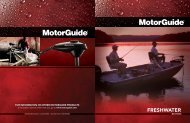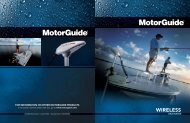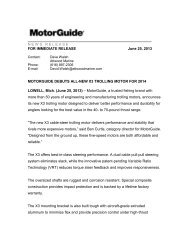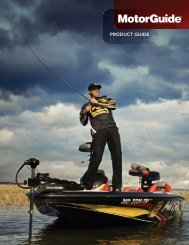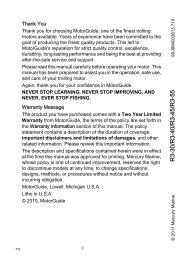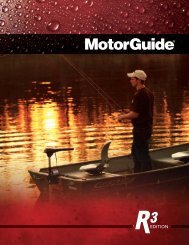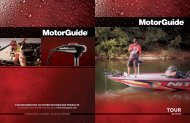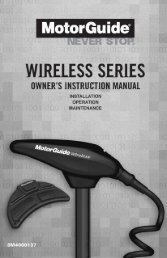Owners Manual - MotorGuide
Owners Manual - MotorGuide
Owners Manual - MotorGuide
You also want an ePaper? Increase the reach of your titles
YUMPU automatically turns print PDFs into web optimized ePapers that Google loves.
WIRING & BATTERY<br />
!<br />
WARNING<br />
Batteries contain sulfuric acid which can cause<br />
severe burns. Avoid contact with skin, eyes, and<br />
clothing. The battery also produces hydrogen and<br />
oxygen gasses when being charged. This<br />
explosive gas is released through the battery<br />
vents and may form an explosive atmosphere<br />
around the battery for several hours after it has<br />
been charged. Electrical arcing or flames can<br />
ignite the gas and cause an explosion which may<br />
shatter the battery and could cause blindness or<br />
other serious personal and property damage.<br />
Refer to your battery manufacturer’s guidelines for<br />
charging instructions.<br />
Establishing a Common Ground<br />
<strong>MotorGuide</strong> recommends isolating the trolling motor<br />
battery/batteries from the main engine battery.<br />
Electrolysis Issues – Using the engine starting battery as<br />
a source of power for any trolling motor may cause<br />
electrolysis on metallic parts.<br />
<br />
<br />
If you have followed the battery wiring and<br />
installation instructions in this manual and your<br />
boat continues to have electrolysis issues, you<br />
will need to separate the trolling motor from any<br />
other boat electronics.<br />
Remove the engine starting battery from the<br />
wiring configuration of the boat and isolate the<br />
power circuit for your trolling motor.<br />
!<br />
Be sure all switches are in the OFF position before<br />
connecting the motor to the batteries. Electrical<br />
arcing near the battery could ignite hydrogen gas<br />
and cause the battery to explode.<br />
!<br />
WARNING<br />
WARNING<br />
Avoid serious injury or death from a possible fire<br />
caused by a direct short; do not jump-start an<br />
outboard motor using the trolling motor<br />
battery/batteries.<br />
• Establish a Common Ground: Common ground<br />
means the ground for the main engine accessories<br />
and your trolling motor are connected to the same<br />
negative ground terminal.<br />
• Not having a common ground can cause severe<br />
corrosion or electrolysis. If left unchecked, damage<br />
may be caused to your trolling motor and boat.<br />
• Establishing a common ground connection will allow<br />
increased sensitivity and improve detail on a sonar<br />
display.<br />
Recommendations<br />
Wire & Cable Routing<br />
• Route trolling motor wires on the opposite side of the<br />
boat from other miscellaneous boat wiring (bow light<br />
wireing, spot light wiring, etc.).<br />
• Transducer installation should be installed according<br />
to the manufacturer’s specifications. To avoid<br />
interference, cables should be routed separately from<br />
the trolling motor power cables.<br />
• IMPORTANT: Do not route the transducer cable<br />
down the trolling motor power cord or foot pedal<br />
assembly cable. Route the transducer cable down<br />
the arm of the mount, then into the bow console.<br />
• Sensitive electronics, depth finders in particular,<br />
should be connected directly to the main engine<br />
battery. If only a one battery system is used, then<br />
connect with separate cables.<br />
• Battery Type – The recommended battery is a 12-<br />
volt Deep Cycle battery.<br />
• Circuit Protection – <strong>MotorGuide</strong> recommends<br />
installing a 50 amp manual-reset circuit breaker in line<br />
with the trolling motor positive leads within (1.8 m) 72<br />
inches of the battery(s). To order a circuit breaker kit,<br />
contact your local Service Dealer, request kit number<br />
MM5870.<br />
• Wire Size – For optimum performance, <strong>MotorGuide</strong><br />
recommends the use of six (6) gauge (13 mm) wire if<br />
extending existing wire beyond the standard battery<br />
cable supplied with the product.<br />
• Bow Plugs – For temporary trolling motor<br />
installations, <strong>MotorGuide</strong> recommends the use of a<br />
quality plug designed for marine applications.<br />
90-MM6900 3



